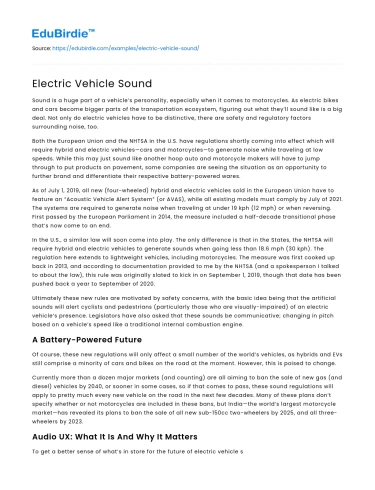Sound is a huge part of a vehicle’s personality, especially when it comes to motorcycles. As electric bikes and cars become bigger parts of the transportation ecosystem, figuring out what they’ll sound like is a big deal. Not only do electric vehicles have to be distinctive, there are safety and regulatory factors surrounding noise, too.
Both the European Union and the NHTSA in the U.S. have regulations shortly coming into effect which will require hybrid and electric vehicles—cars and motorcycles—to generate noise while traveling at low speeds. While this may just sound like another hoop auto and motorcycle makers will have to jump through to put products on pavement, some companies are seeing the situation as an opportunity to further brand and differentiate their respective battery-powered wares.
Save your time!
We can take care of your essay
- Proper editing and formatting
- Free revision, title page, and bibliography
- Flexible prices and money-back guarantee
As of July 1, 2019, all new (four-wheeled) hybrid and electric vehicles sold in the European Union have to feature an “Acoustic Vehicle Alert System” (or AVAS), while all existing models must comply by July of 2021. The systems are required to generate noise when traveling at under 19 kph (12 mph) or when reversing. First passed by the European Parliament in 2014, the measure included a half-decade transitional phase that’s now come to an end.
In the U.S., a similar law will soon come into play. The only difference is that in the States, the NHTSA will require hybrid and electric vehicles to generate sounds when going less than 18.6 mph (30 kph). The regulation here extends to lightweight vehicles, including motorcycles. The measure was first cooked up back in 2013, and according to documentation provided to me by the NHTSA (and a spokesperson I talked to about the law), this rule was originally slated to kick in on September 1, 2019, though that date has been pushed back a year to September of 2020.
Ultimately these new rules are motivated by safety concerns, with the basic idea being that the artificial sounds will alert cyclists and pedestrians (particularly those who are visually-impaired) of an electric vehicle’s presence. Legislators have also asked that these sounds be communicative; changing in pitch based on a vehicle’s speed like a traditional internal combustion engine.
A Battery-Powered Future
Of course, these new regulations will only affect a small number of the world’s vehicles, as hybrids and EVs still comprise a minority of cars and bikes on the road at the moment. However, this is poised to change.
Currently more than a dozen major markets (and counting) are all aiming to ban the sale of new gas (and diesel) vehicles by 2040, or sooner in some cases, so if that comes to pass, these sound regulations will apply to pretty much every new vehicle on the road in the next few decades. Many of these plans don’t specify whether or not motorcycles are included in these bans, but India—the world’s largest motorcycle market—has revealed its plans to ban the sale of all new sub-150cc two-wheelers by 2025, and all three-wheelers by 2023.
Audio UX: What It Is And Why It Matters
To get a better sense of what’s in store for the future of electric vehicle sound, I talked to audio UX (User eXperience) designer, Connor Moore, the force behind the San Francisco-based, CMoore Sound. Moore’s clients include Google, Amazon, Uber, and Twitter, and he’s currently doing audio UX work for Tesla, so he knows a thing or two about designing sound for a vehicle.
Connor said good audio UX has to “first and foremost be communicative to its user,” intuitively guiding them through an experience. He also stressed the importance of uniformity, with the auditory alerts and tones sounding like they’re coming from the same family, relating in timbre and composition. Everything from the sounds coming from an infotainment system, to the acoustics of a door opening and closing; it’s all extremely calculated.
“A high-quality audio user experience should elevate the driving experience,” explained Moore. “It should not dominate the experience, but support the user on their journey by adding functionality in communication while also adding moments of delight that the user will remember. It should be subtle yet engaging. These small details are things, whether consciously or subconsciously, that people really notice and it influences the way they spend their time and money.”






 Stuck on your essay?
Stuck on your essay?

